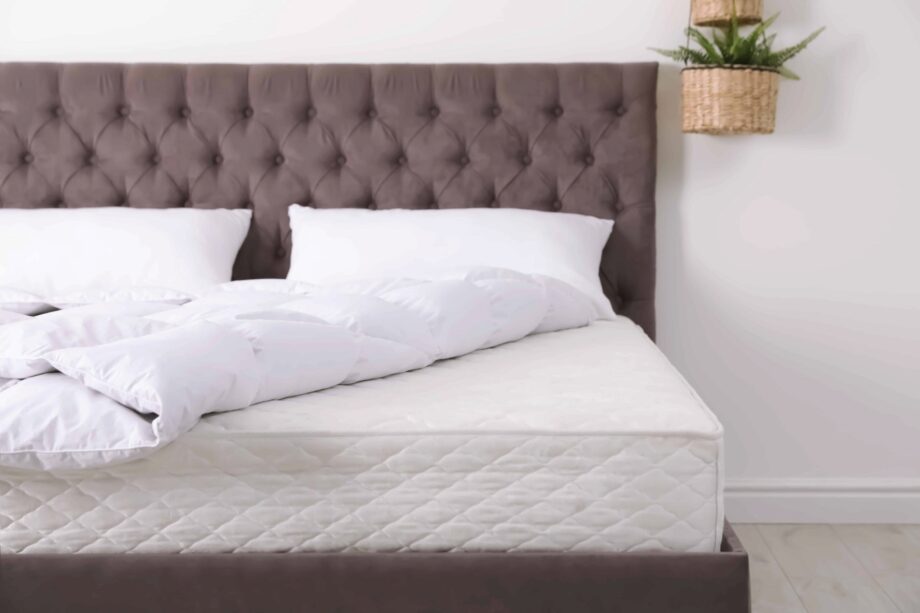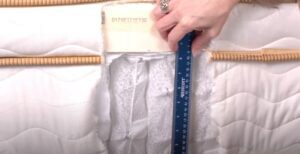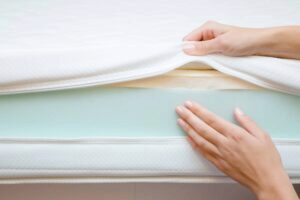Types of Mattresses
Disclosure: By clicking on the product links in this article, Mattress Nerd may receive a commission fee at no cost to you, the reader. Read full disclosure statement.
What type should I get?
This is a question at the front of anyone’s mind who’s in the market for a new mattress or simply likes talking about mattresses in their spare time – you know, like we do. The type of mattress you choose has a significant impact on how well it will address your unique needs to achieve a great night’s sleep.
There are pros and cons to the fact that the seemingly simple world of mattress-shopping is long gone. On one hand, consumers have access to just about any mattress they can dream of. On the other hand, many shoppers have no idea where to start when it comes to selecting the right bed for their bodies. To help you sift through the information, we’re outlining the most common mattress types in this article, including how they’re made, their benefits, and any drawbacks you should consider.

Memory Foam
This type of mattress has been around for almost four decades. If you’ve ever seen a mattress commercial where a happy-go-lucky individual pressed his or her hand into the mattress, leaving an impression that ever so slowly springs back up, that’s memory foam.
Pros
- Fits closely around the body to create a “sinking in” sensation
- Comfortable material, cradling the body for pressure point relief
- Motion isolation/low motion transfer
- Layers of foam resist sagging in the middle
- Offers hip and shoulder support for side sleepers
Cons
- May sleep hot, but advancements in foam technology, like gel foam, have helped solve this
- Won’t conform quickly enough if you move around often during sleep
- Some people experience a slight odor from the mattress
- Can be pricey depending on the brand
Latex
Latex mattresses are the leading natural bedding option of the pack. Their main component is derived from the sap of a rubber tree. These beds are known for being affordable, durable, and come in varying levels of firmness to accommodate all sleeping positions.
Pros
- Highly comfortable
- Supportive, pushing and elevating the body
- Conforms to the body more quickly than memory foam (i.e. contours without sinking)
- Eco-friendly, avoiding harsh chemicals and allergens
- Naturally temperature neutral
- Durable — Can last up to 20 years
- Great for people with low-back pain and plus-size sleepers
Cons
- Tend to be expensive, but payment plans are sometimes offered
- Not all latex is the same quality; consumers should do their research
- Some people are allergic to latex
Traditional Innerspring
I’d bet my bottom dollar that you’ve slept on an innerspring mattress at some point in your lifetime. That’s because they used to be the bread and butter of the mattress industry, with their original technology dating back to the 1800s. Still, they’re the most popular mattress type and are constructed with steel or metal coils and a top layer of foam.
Pros
- Affordable
- Offer a springy feel
- Provide firmness and support
- Great versatility in selection and springs
- Among the coolest mattresses available, thanks to the air between coils
Cons
- May be too firm for some
- Can be noisy with audible squeaking when you move around
- Tend to wear out faster
Hybrids
A hybrid mattress marries the best of two or three mattress types to create what some people consider the ideal sleeping surface. With this type of mattress, you’ll get the support and bounce of innerspring construction in addition to the comfort of foam (latex or memory) in the top layers.
Pros
- Popular among consumers and in the industry at large
- Highly customizable, meaning there’s something for everyone
- Foam and coils
- Coils and latex
- Coils, foam and latex
- Balances support and softness
- Easier to move around than a foam mattress
- Contours to the body better than an innerspring mattress
Cons
- Possibility of structural weakness due to the combination of materials used
- The availability of options and types can be overwhelming for consumers
Pillow Tops
Pillow top mattresses can be innerspring or foam mattresses. What qualifies them as a pillow top is the presence of a soft, comfort layer that’s stitched on top to provide extra cushion and comfort. This layer can be several inches thick and is either sewn flush with the mattress or can resemble a pillow sitting atop the mattress with hidden stitching that holds it in place.
Pros
- At least two inches of added comfort
- Can relieve aches and pains, especially for side sleepers
- Less likely to release chemicals than their foam counterparts
- You can choose the level of softness
Cons
- The pillow top may shift, but improved stitching typically eliminates this issue
- Foam pillow-top mattresses can be more difficult to find
- Tend to be an added cost
- Some manufacturers may not offer this option
Adjustable Beds
The term adjustable bed refers to a mattress with a base that can be raised and lowered in certain areas, usually at the head and the foot, to create various angles for sleeping and enjoying other activities in bed. They also come with a host of other features, ranging from massaging surfaces to heating and cooling, and can be configured using a remote.
Pros
- Foot elevation can help with poor circulation and medical procedure recovery
- Elevating the head can reduce snoring, heartburn, and acid reflux
- Makes a variety of activities, such as watching TV, eating breakfast, breastfeeding, or reading in bed easier
- Partners can adjust their side of the bed independently of the other
- May have USB chargers for tablets and iPhones
Cons
- Sleepers can risk injury if a hand or limb is placed between the foundation and the frame as it’s being moved
- If used incorrectly, can aggravate back pain
- Since it’s electronic, there’s a higher risk of mechanical failure
Other (Less Common) Mattress Types
Waterbeds
If you grew up in the 80s, you know what a waterbed is. In fact, you may have slept on one! Waterbeds are water-filled mattresses made from a polyvinyl material with a stretchy top layer for comfort. While sometimes considered a novelty item, these can be a viable alternative to traditional mattresses for certain individuals.
Pros
- High comfort level, relaxing the spine and providing relief for back pain
- Offer no resistance, decreasing pressure on the joints
- Can be heated during the cold winter months
- Heating capability can enhance muscle relaxation and joint relief
- Good for allergies, with no fibers on which dirt or dust can settle
Cons
- Poor support, with little body contouring
- Punctures can cause frequent leaks
- Some waterbeds develop a strange odor over time
- Sheets fitted to a waterbed may be difficult to find
Air Beds
If you read the words air bed and immediately think of high school sleepovers and noisy inflation machines, hold your horses. An air bed is different than an air mattress; air beds look like your average mattress and are often made with layers of foam in addition to an air layer that can be refilled.
Pros
- Some air beds offer multiple settings to accommodate you and your sleep partner’s needs
- Easy ability to change the firmness level
- Sagging is never an issue since it can be refilled
Cons
- Tend to come with lower-quality warranties
- A pump may be required
- Can be expensive
- May need to get used to the feel
Now that you understand the many types of mattresses available today, check out our ultimate mattress buying guide to find the perfect bed for your body type and comfort preferences. Keep in mind that ultimately, the type, price, manufacturer, and a number of coils in your mattress don’t matter as much as how it feels to you. Because without sleeping on a structure you are comfortable on, you’ll never be able to achieve restful sleep.


